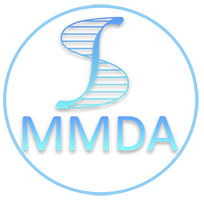2023
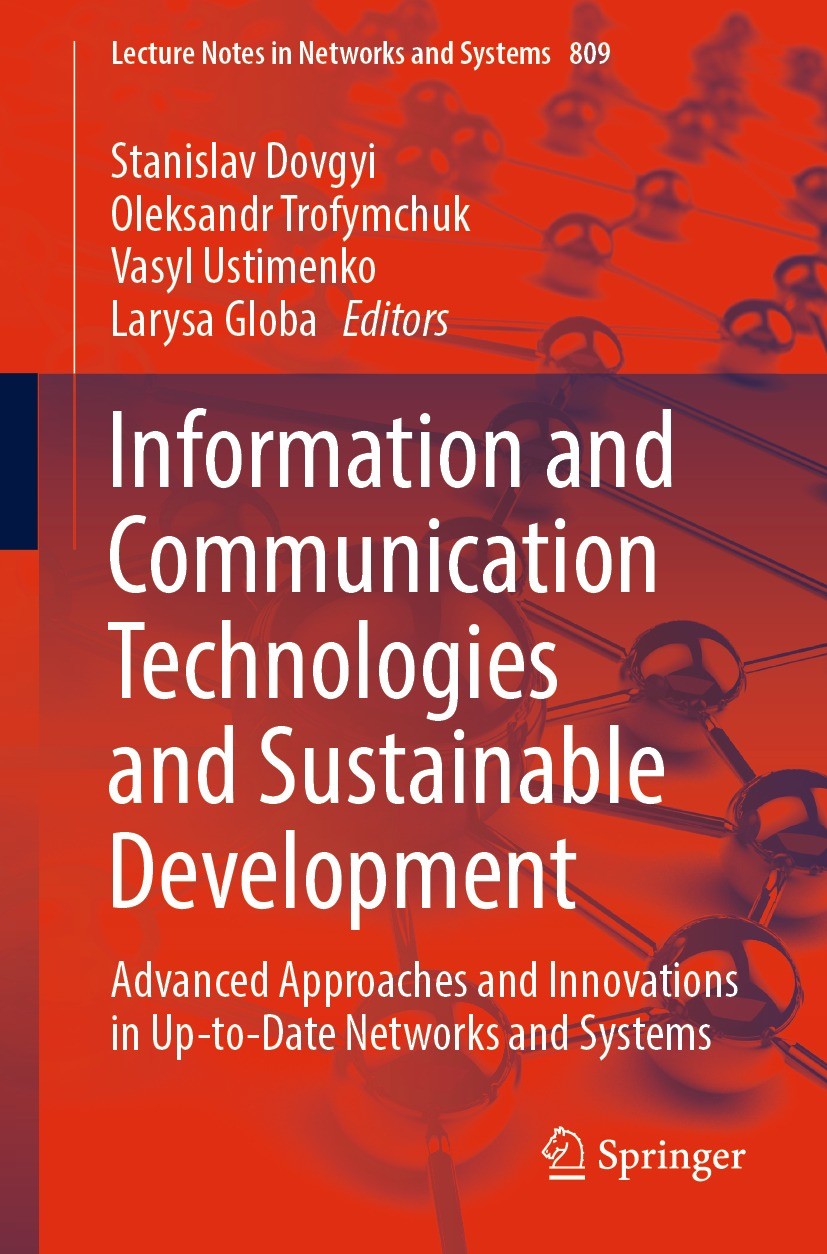
Nataliia Kussul, Andrii Shelestov & Bohdan Yailymov
Dovgyi, S., Trofymchuk, O., Ustimenko, V., Globa, L. (eds) Information and Communication Technologies and Sustainable Development. ICT&SD 2022. Lecture Notes in Networks and Systems, vol 809. Springer, Cham, pp 303–321.
https://doi.org/10.1007/978-3-031-46880-3_19
Print ISBN 978-3-031-46879-7
Online ISBN 978-3-031-46880-3
This paper addresses the problem of processing large volumes of satellite data and compares different cloud platforms for potential solutions. Existing cloud platforms like Google Earth Engine, Amazon Web Services (AWS), and CREODIAS have been used to tackle this challenge. However, this study proposes an optimal pipeline for satellite data processing, taking into account the advantages and limitations of each platform. The specific focus is on solving machine learning problems using satellite data. In the experiment conducted, the effectiveness of each cloud platform was analyzed. It was found that cloud platforms offer benefits such as flexibility, access to computing resources, and parallel processing architectures, leading to increased productivity and cost reduction. CREODIAS, in particular, stands out due to its specialization in satellite data and easy access to various data types, along with tools for data searching and visualization. The experiment demonstrated that tasks, from data loading to classification, were executed fastest on CREODIAS resources. However, AWS performed data classification faster. The availability of its own internal data bucket was a significant advantage of CREODIAS, especially when considering ARD data. These findings contribute to the advancement of AI methodologies and have practical implications for solving satellite monitoring applications.
Chapter. Current Advances on Cloud-Based Distributed Computing for Forest Monitoring
Andrii Shelestov, Yevhenii Salii, Nataliia Hordiiko, Hanna Yailymova
Dovgyi, S., Trofymchuk, O., Ustimenko, V., Globa, L. (eds) Information and Communication Technologies and Sustainable Development. ICT&SD 2022. Lecture Notes in Networks and Systems, vol 809. Springer, Cham, pp 322–336. https://doi.org/10.1007/978-3-031-46880-3_20
Print ISBN 978-3-031-46879-7
Online ISBN 978-3-031-46880-3
One of the most important tasks related to environmental protection is forests monitoring. Meanwhile, specialists deal with the problem of big data and the need to utilize powerful computing resources that are not always available. Cloud solutions (CREODIAS, Google Earth Engine, etc.) provide instant satellite data access and the ability to quickly and conveniently process geospatial data in the cloud and use it to search for information products. Forest monitoring is supported by the European Commission (EU project SWIFTT), the World Wildlife Fund and others. This work analyzes Sentinel-2 satellite spectral channels, which distribution of pixel values was constructed for diseased and healthy forests, and the possibility of separating these two classes was analyzed based on the Bhattacharya distance. The informativeness of time series application of the normalized difference vegetation index (NDVI) was analyzed. The assumption that the average value of NDVI decreases and the standard deviation increases when the forest changes is confirmed. Getting results for large areas will lead to a big data problem. Therefore, the structure of the pilot information system is proposed as the basis for a further cloud solution with the development of a machine (deep) learning model for forest monitoring in any territory (including Ukraine). This system allows monitoring forests dynamics based on time series of satellite data at the country level and worldwide. This will be an important step for Ukraine as a potential member of the EU in the field of providing information services and monitoring the most sensitive natural resources.
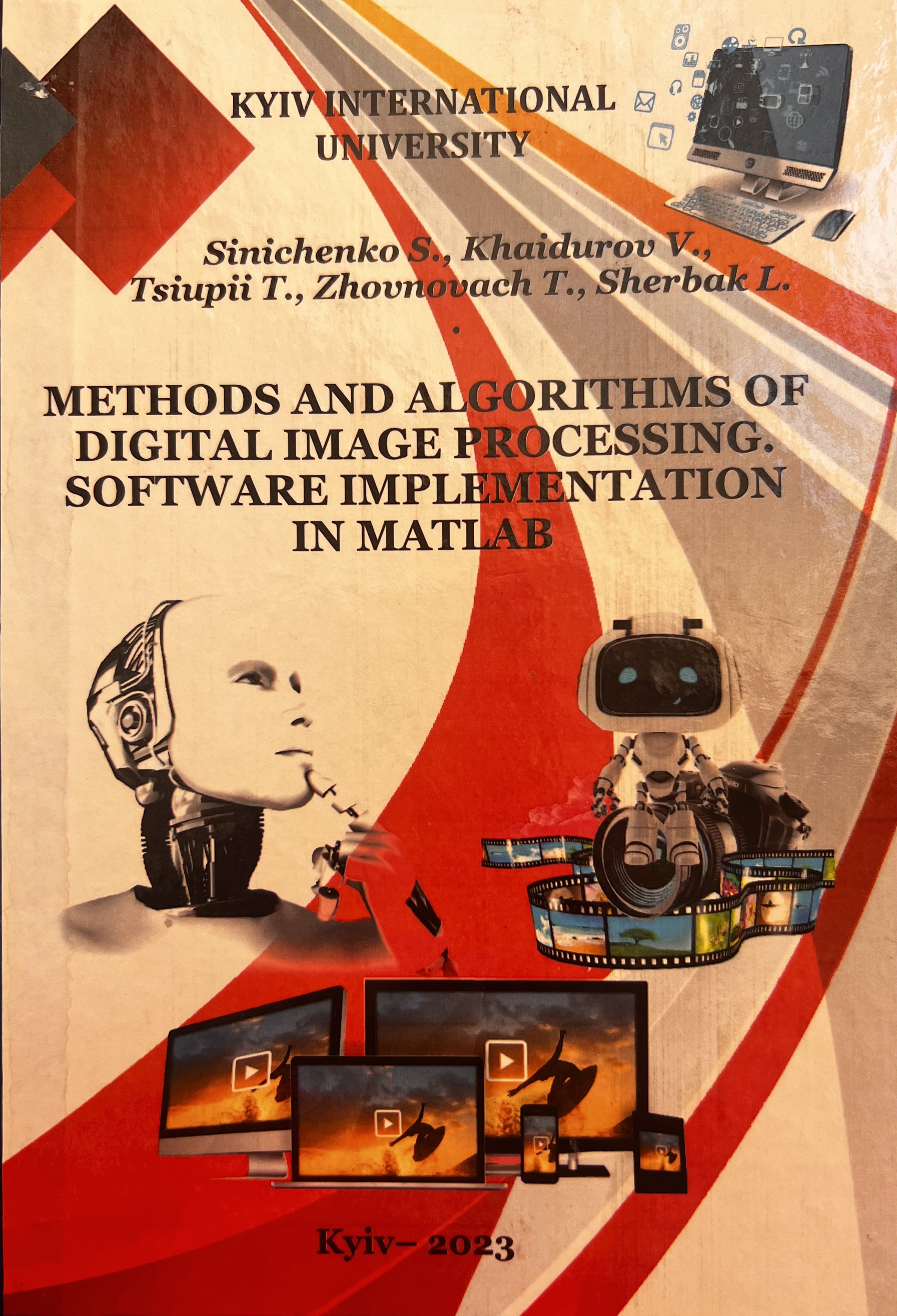
Methods and algorithms of digital image processing. Software implementation in Matlab: tutorial for students majoring in 121 – “Software Engineering”, 125 – “Cybersecurity”
Sinichenko S., Khaidurov V., Tsiupii T., Zhovnovach T., Sherbak L.
Kyiv International University, 2023, 292 p.
ISBN 978-617-651-232-5
The textbook contains methods and algorithms for digital image processing used to highlight the contours of graphic elements in images, methods of interpolating images using numerical interpolation methods, methods of modem digital image processing in various applications based on tl1e equations of mathematical physics and graphic processing methods real-time with elements of machine learning. The guide pгovides steganographic digital image processing techniques that are widely used іn the protection of graphics, sach as copyright objects.
The appendices of the manual contain the mаіn software implementations of methods and algorithms in the MATLAB application software package, which are used in practice, as well as the results of experiments of the cosidered problems.
Тhе textbook is intended for students majoring іn Computer Science and lnformatioп Тесhnоlоgу, graduate students of technical specialties, teachers аnd researchers involved in digital graphics processing.
Download content here>>>
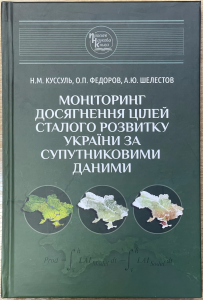 Моніторинг досягнення цілей сталого розвитку України за супутниковими даними
Моніторинг досягнення цілей сталого розвитку України за супутниковими даними
Н.М. Куссуль, О.П. Федоров, А.Ю. Шелестов.
К.: “Наукова думка” – 2023. – 164 с.
DOI: https://doi.org/10.15407/978-966-00-1865-5
ISBN: 978-966-00-1865-5
У монографії розглянуті результати розроблення та впровадження українськими вченими інформаційних технологій та сервісів оцінювання індикаторів сталого розвитку на основі використання супутникових даних спостереження за Землею. Робота спрямована на вирішення актуальних соціально-економічних проблем, зокрема, досягнення сформульованих ООН цілей сталого розвитку, моніторинг глобальних кліматичних змін, катастрофічних подій. Запропоновано методологію визначення індикаторів сталого розвитку, інформаційні технології їх обчислення на основі супутникових даних та продуктів їх обробки з використанням сучасних хмарних технологій. Зокрема йдеться про впровадження в Україні ідеології створюваної міжнародної системи систем спостереження Землі GEOSS та європейської програми Copernicus. Набутий досвід дозволяє запропонувати ідеологію українського сегменту GEOSS – інформаційної системи UkrGEO, яка передбачає інтеграцію та експлуатацію багатьох нових наборів супутникових даних, а також істотної модернізації національних статистичних і геопросторових систем в контексті цифровізації економіки та індустрії 4.0.
Для фахівців в галузі космічних інформаційних технологій, супутникових спостережень за Землею, геоінформаційних систем, екологічної безпеки, сталого розвитку, а також аспірантів та студентів відповідних спеціалізацій вишів.
2022
 Chapter. Cloud-Based Technologies for Data Processing in Ukraine: International Context
Chapter. Cloud-Based Technologies for Data Processing in Ukraine: International Context
Andrii Shelestov, Bohdan Yailymov, Hanna Yailymova, Svitlana Nosok, Oleh Piven.
Ilchenko, M., Uryvsky, L., Globa, L. (eds) Progress in Advanced Information and Communication Technology and Systems. MCiT 2021. Lecture Notes in Networks and Systems, vol 548. Springer, Cham. pp. 101–118
DOI: 10.1007/978-3-031-16368-5_5
During last time we have faced with big data problem in Earth observation domain. Fortunately, cloud solutions such as Amazon Web Services, Google Earth Engine and others platforms provide an access to Sentinel-1, Sentinel-2 and Landsat data with spatial resolution from 10 to 30 m, opportunities for quick and convenient way of geospatial data processing and usage for a lot of different information products retrieval like land cover classification maps, crop state monitoring etc. During last few years we had experience of cloud-based technologies usage within scientific and innovation projects, which are supported by European Commission, World Bank, United Nations Development Program, GEO Committee and have experience of open-source software development and machine (deep) learning usage in cloud environment, namely Open Data Cube. This package provides the opportunities for data collection, deployment and provision on the base of 3D model of data representation. The developed technologies are implemented on diverse cloud platforms and solve various types of applied problems, in particular, monitoring of agricultural lands, assessment of sustainable development indicators at the national level. All of these questions will be described in our chapter in more detail.
 Chapter. Mathematical Models and Informational Technologies of Crop Yield Forecasting in Cloud Environment
Chapter. Mathematical Models and Informational Technologies of Crop Yield Forecasting in Cloud Environment
Leonid Shumilo, Sofia Drozd, Nataliia Kussul, Andrii Shelestov, Sergiy Sylantyev
Ilchenko, M., Uryvsky, L., Globa, L. (eds) Progress in Advanced Information and Communication Technology and Systems. MCiT 2021. Lecture Notes in Networks and Systems, vol 548. Springer, Cham. pp. 143–164.
DOI: 10.1007/978-3-031-16368-5_7
The agricultural sector plays a very important role in the country’s economy. Often, crop failures are the cause of protracted financial crises, which are very difficult to overcome. Fortunately, modern scientific methods allow us to predict the yield of certain crops in selected fields based on data on soil properties and weather conditions. Such study requires high-resolution data, the downloading and processing of which requires the involvement of powerful cloud infrastructures, graphics processors and other technological solutions. Involvement of these technologies and reliable forecasting of yield help to make the right decision about sowing and avoid crop failure. However, collecting data on soil properties directly from agronomists and local farmers is a very long and hard process. In addition, the data collected may be inaccurate and expensive. As a result, a process will be launched that will eventually lead to an agrarian and financial crisis. However, a solution to this problem has already been found. Remote sensing data together with biophysical models has long been used in the world. In this section the state-of-the-art and current results in this area have been done.
2020
 Chapter 18. Measurement Techniques. In Agroclimatology (eds J.L. Hatfield, M.V. Sivakumar and J.H. Prueger): Linking Agriculture to Climate
Chapter 18. Measurement Techniques. In Agroclimatology (eds J.L. Hatfield, M.V. Sivakumar and J.H. Prueger): Linking Agriculture to Climate
Howard, A., Chipanshi, A., Davidson, A., Desjardins, R., Kolotii, A., Kussul, N., McNairn, H., Skakun, S. and Shelestov, A.
2020. – Vol. 60. – P. 489-517
DOI: 10.2134/agronmonogr60.
Major themes of the book include: principles of energy exchange and climatology, understanding climate change and agriculture, linkages of specific biological systems to climatology, the context of pests and diseases, methods of agroclimatology, and the application of agroclimatic principles to problem-solving in agriculture.
Chapter 18 aims to identify key state of the art operational or near‐operational techniques and discusses them at scales that are relevant to agricultural production. It covers soil moisture measurement techniques that are available over a range of scales. Soil moisture is a key variable for crop productivity, crop management practices, flood and excess moisture risk, and is a controlling factor in greenhouse gas emissions from farming operations. Crop condition and drought monitoring techniques have been used as early warning for production and food security issues. Quantification of drought severity was originally based on meteorological and/or hydrological data. The chapter presents two case studies that apply the concepts and techniques toward measurement of the elements. The case studies presented are crop condition assessment in the Ukraine and the carbon footprint of beef in Canada.
2019
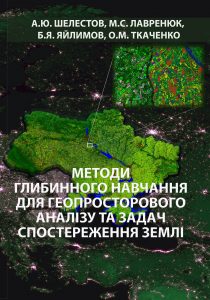 Методи глибинного навчання для геопросторового аналізу та задач спостереження Землі
Методи глибинного навчання для геопросторового аналізу та задач спостереження Землі
Шелестов А. Ю., Лавренюк М. С., Яйлимов Б. Я., Ткаченко О. М.
К.: “Наукова думка” – 2019. – 228 с.
Книгу присвячено розробці методів геопросторового аналізу та розвязанню задач спостереження Землі, зокрема, класифікації земного покриву. Ці методи базуються на використанні інтелектуальних підходів до обробки геопросторових даних великого об’єму, таких як глибинне навчання.
2018
 Despeckling of Multitemporal Sentinel SAR Images and Its Impact on Agricultural Area Classification
Despeckling of Multitemporal Sentinel SAR Images and Its Impact on Agricultural Area Classification
Vladimir Lukin, Oleksii Rubel, Ruslan Kozhemiakin, Sergey Abramov, Andrii Shelestov, Mykola Lavreniuk, Mykola Meretsky, Benoit Vozel and Kacem Chehdi
In Recent Advances and Applications in Remote Sensing. IntechOpen (Chapter 2). – 2018. – P. 21-40.
This chapter addresses an important practical task of classification of multichannel remote sensing data with application to multitemporal dual-polarization Sentinel radar images acquired for agricultural regions in Ukraine. We first consider characteristics of dual-polarization Sentinel radar images and discuss what kind of filters can be applied to such data. Several examples of denoising are presented with analysis of what properties of filters are desired and what can be provided in practice. It is also demonstrated that the use of preliminary denoising produces improvement of classification accuracy where despeckling that is more efficient in terms of standard filtering criteria results in better classification.
